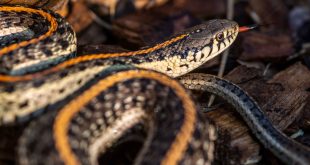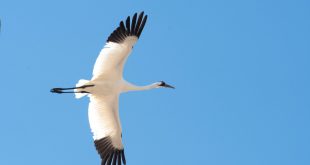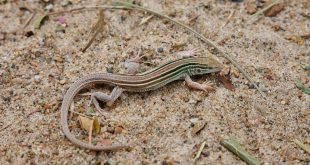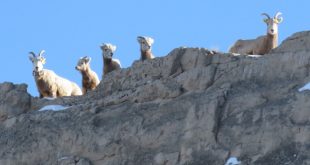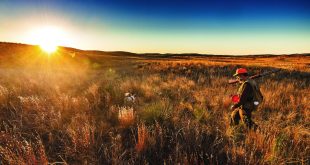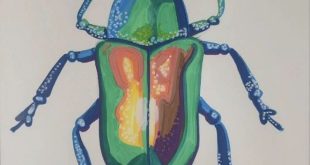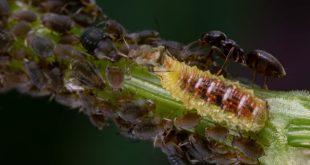Something of a mystery, Nebraska’s bobcat population remains healthy. By Justin Haag As I moved among patches of shoulder-high weeds at an abandoned farmstead in search of pheasants, I glanced over to see my younger brother, fresh out of hunter-safety training, become excited as he entered a clearing. “Whoa, what was that? It looked like a lion,” he shouted as an unfamiliar creature scurried into cover. Despite any skepticism by those of us in the hunting party that day, we …
Read More »A Guide to the Garter Snakes of Nebraska
Read about the four garter snake species of Nebraska. By Monica Macoubrie, Wildlife Education Specialist Most people don’t think about snakes in November, but with the near record high temperatures this year, some snakes are still slinking through the grasses or moving through our backyards in certain areas of Nebraska. One common inhabitant that you may still see lurking about your yard, soaking up the last warm rays of the fall, is the garter snake. No, not “garden snake” or …
Read More »Shot Down in World War II
A story of survival and luck during World War II in the South China Sea. By David L. Bristow, History Nebraska U.S. Navy Ensign John Doyle’s chances of surviving World War II seemed bleak on Nov. 25, 1944, as he struggled to hold his burning dive bomber on target over the South China Sea,” writes Samuel Van Pelt. “While attacking a Japanese heavy cruiser, anti-aircraft fire damaged his plane, but Doyle still managed to release his bomb and score a …
Read More »At-Risk Species Spotlight – Whooping Crane
The recovery of whooping crane populations is an on-going, collaborative effort across multiple states, countries and conservation groups. By Olivia DaRugna, Wildlife Diversity Biologist Whooping Cranes are one of the rarest birds in the world. In the 1940s, whooping cranes declined to fewer than two dozen individuals due to unregulated shooting and loss of nesting habitat. This drastic decline led to whooping cranes being one of the first species to gain protection under the Endangered Species Act in 1973. Whopping …
Read More »A River Used to Run Through It – Red Wing Wildlife Management Area
Situated along the Elkhorn River, Red Wing Wildlife Management Area is a haven for wildlife. Story and photos by Eric Fowler Dams, diversions and development have changed many rivers in Nebraska. The Elkhorn River is not one of them. It still winds its way through the northeastern Nebraska countryside, its channel slowly shifting course from year to year. During floods, those shifts can be drastic. That is what happened sometime early in the 20th century at what would, in 1977, …
Read More »Lizards of Nebraska
Four families of lizards can be found in Nebraska, with a total of 10 different species. By Monica Macoubrie, Wildlife Education Specialist Take a quick hike through the prairies of western Nebraska or the rocky terrain bordering Kansas, and you may see a scampering reptile with a long slender tail. Don’t panic — it’s not a snake. It’s just the most underrated reptile of all: lizards. With 6,000 species worldwide, one could say that lizards have been rather successful. They …
Read More »November Wildlife Viewing – Bighorn Sheep
November is a great time for viewing bighorn sheep in the Nebraska Panhandle. By Olivia DaRugna, Wildlife Diversity Biologist Before the 1900s, Audubon bighorn sheep inhabited parts of western Nebraska, including the Wildcat Hills, the Pine Ridge and along the North Platte River from the Wyoming state line to eastern Lincoln County. It was thought that the Audubon bighorn became extinct in the early 1900s, with its last stronghold being the South Dakota badlands. Since 1981, the Nebraska Game and …
Read More »Upland Hunting the Sandhills – A Scientific Approach
A wildlife biologist at the Valentine National Wildlife Refuge shares his perspectives on one of his favorite pastimes: hunting prairie grouse. By Justin Haag Melvin Nenneman knows birds. As wildlife biologist for the 71,516-acre Valentine National Wildlife Refuge the past 21 years, he’s become familiar with flying creatures that range in size from the huge pelicans cruising the shallow lakes to minute grasshopper sparrows flittering about the rolling, grass-covered dunes. He and his coworkers strive to preserve and maintain the …
Read More »The Art of Observation
Blend observation and art to appreciate the natural world. By Grace Gaard, Aquatic Ecology Education Specialist The month of October is notoriously busy no matter what you’re involved in: Hunting seasons begin, sports are in full swing, camping weather is wonderful, and everyone is soaking up the last of fall’s warmer weather. During this time of so much transition and activity, do you ever take a deep breath and slow down? As an artist and an outdoor enthusiast, I find …
Read More »Protecting the Flock – Ants and Aphids
Ants raise aphids to harvest their sugar-rich waste secretions known as honeydew. By Tyler Moore, Bellevue University With more than 15,000 described species of ants, as noted in “Bolton’s Catalogue of the Ants of the World,” these organisms are among the world’s most successful and represent a total estimated biomass of 12 megatons. They have also long been the subject of amateur naturalists and scientists, with perhaps no behavior more intriguing than the “farming” of aphids. Aphids are commonly known …
Read More » Nebraskaland Magazine
Nebraskaland Magazine

